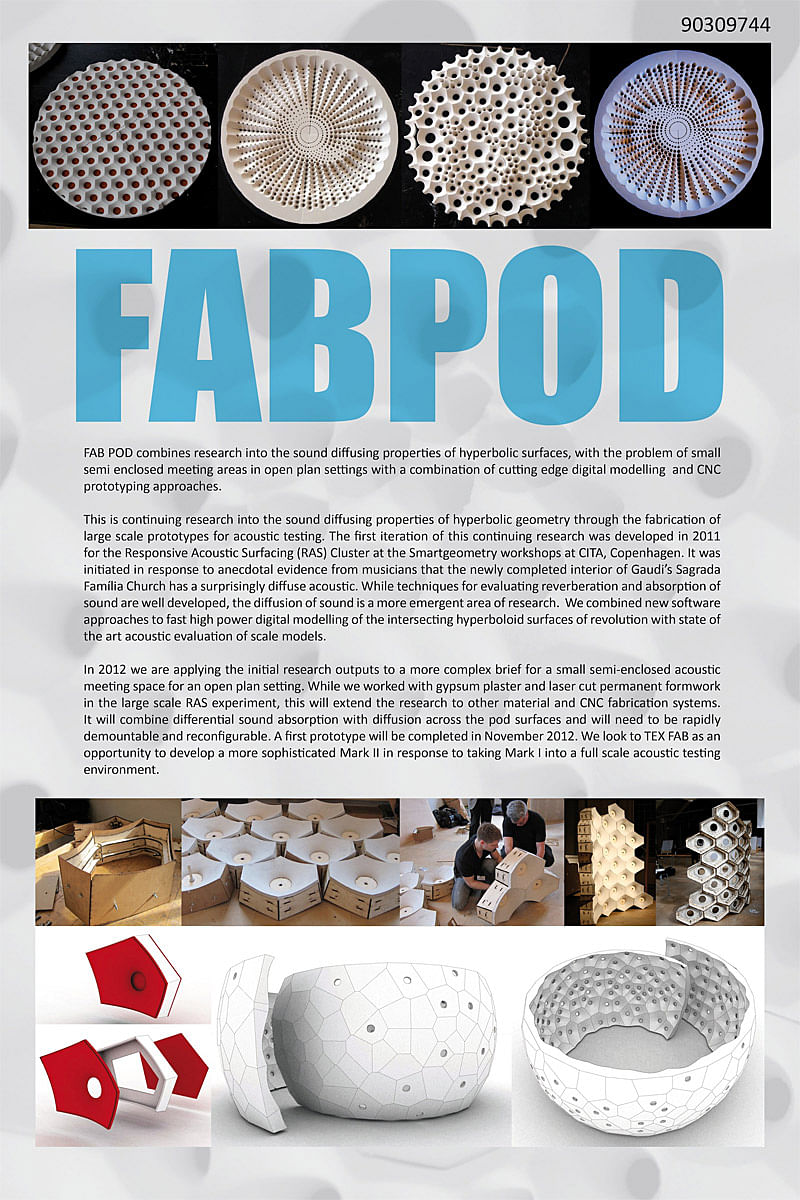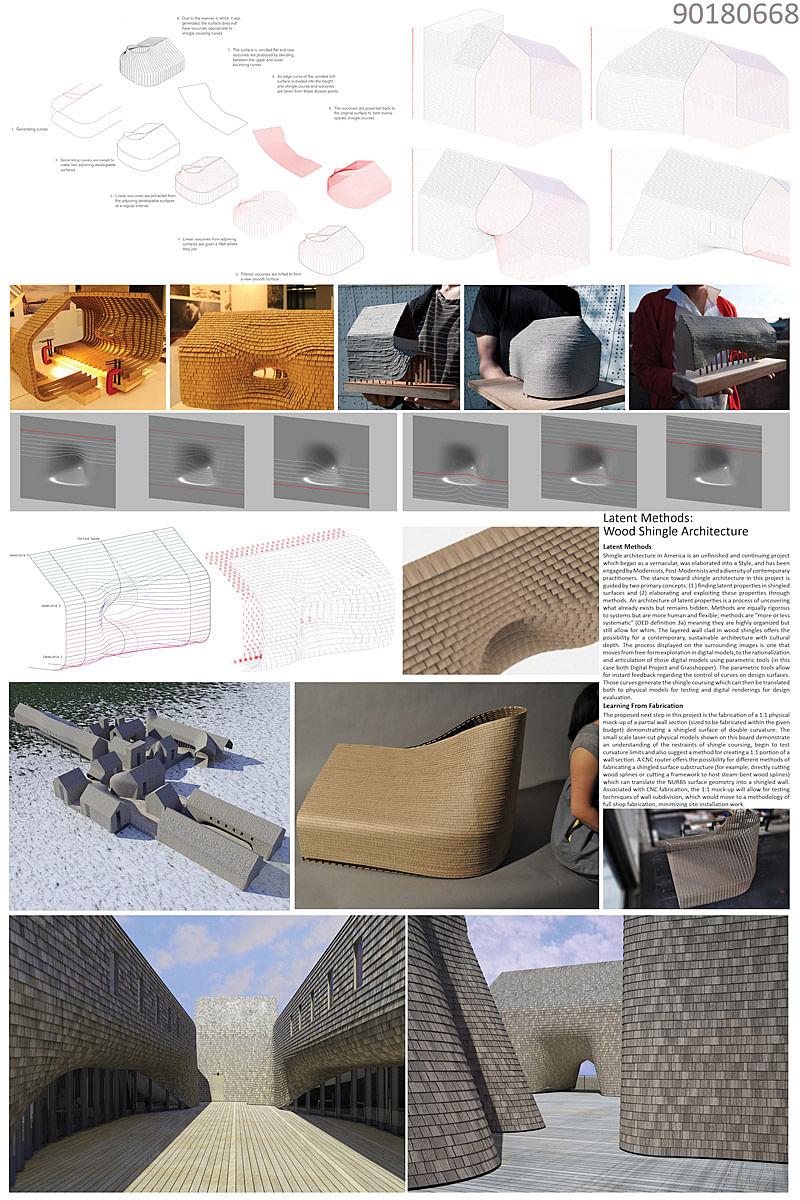Finalists of APPLIED Research Through Fabrication Competition
By Bustler Editors|
Monday, Jun 18, 2012

Related
Four projects have today been announced as First Round Finalists in TEX-FAB Digital Fabrication Alliance’s 2012 international competition, APPLIED Research Through Fabrication.
In the two categories 'Continuing Research' and 'Speculative Research,' a total of 68 entries from 13 countries on 4 continents with roughly an even split between the two were received. Proposals dealing with acoustics, material structure, ambient light occlusion and movement monitoring through haptic and sensory relays all bid to proceed to the second round with $1,000 in funding.
Jury members Gil Akos and Ronnie Parsons from Studio Mode, Billie Faircloth from Kieran Timberlake, Jonathan Mallie from SHoP and Jason Vollen from C.A.S.E. convened on June 11 to deliberate over their initial short-list of 12 selections.
Over the next 4 months, the finalists will further develop their proposals into larger scale prototypes and mock-ups to test feasibility and technique. Afterwards, they are to be exhibited at ACADIA 2012 next October at the Synthetic Digital Ecologies conference which is hosted at the California College of the Arts. At that time, the second round will be juried and a winner will be chosen that will be build, full scale in Dallas, Texas for the TEX-FAB 4.0 conference.
The Second Round Jury will be comprised of Nader Tehrani, Head of Jury (NADAAA); Andrew Kudless (Matsys Design); Vlad Tenu (V. Tenu); and Neri Oxman (Neri Oxman).
These are the four First Round Finalists:
First Round Finalist - Continuing Research:
FAB POD by Jane Burry and Nicholas Williams
Fab Pod proved to be a clear choice for the jury as little deliberation was needed to narrow down its strengths as a finalist. Noted by the jury, ‘the use of the digital tools to create a true performative surface, that is not about shading, is refreshing. Acoustics in architecture is highly mathematical, often understood by only those in the discipline of acoustic sciences, and often the expressions of performance are lost in the overall design of acoustically performing spaces. This project is one of a new breed of digitally related expressions where form and performance are seeking equal ground.’

First Round Finalist - Continuing Research:
SPIN-VALENCE by Emily Baker
The jury’s comments ranged over time from disinterest to support as this underdog, with just one initial vote, gained more appeal and finally was narrowed down as a finalist. Noted during the deliberation as having a thorough understanding on the means and methods of its potential, despite its overtly ‘simplistic’ process, Spin-Valence ultimately garnered quite a lot of praise in its ‘technique not developed to rationalize a complex form, rather the technique imposes an advanced structural integrity of a flat surface without cost implications of additive structural members’.

First Round Finalist - Speculative Proposal:
CAST THICKET by Christine Yogiaman and Ken Tracy
In the initial conversations about Cast Thicket, the jury found that it ‘offers a promising example of hybridizing contemporary means of representation and production with more traditional means of construction.’ Upon further review and some inspired deliberation issues arose that warranted some pause. Being that the proposal did not necessarily require being cast as inherent to its formal articulation, as the design could be realized in metal or other. The jury however, given the thoroughness and potential in Cast Thicket’s development, sided on enabling the exploration, underpinning the desire to support the role of basic research in the competition brief, where an outcome is not known.

First Round Finalist - Speculative Proposal:
LATENT METHODS by Eli Allen
With broad and open support, Latent Methods was chosen for its ‘clear as well as critical framework for the exploration of contemporary surface effects through the reevaluation of the shingle architecture vernacular. Another juror summed up their thoughts with no uncertain resolve, ‘one word - Architecture. With roots dating to the middle ages in Europe, nothing digital is needed for this project at all, yet, it is by far the most purely architectural of all the speculative entries.’ Ultimately the jury chose Latent Methods over the other entries with minimal deliberation as noted above that it presented a direct connection to past that informed by an intelligent use of digital means, would greatly benefit from further exploration.

An additional two proposals were chosen as Honorable Mentions at the discretion of the jury due to their skill and effort in presenting proposals of high merit.
Honorable Mention - Continuing Research:
CURVED DIE | CREASED STRUCTURE by Brigette Borders and Justin Fabrikant
With deliberation noting its interesting formal development that is generated from the ‘process’, Curved Die | Creased Structure, ‘presents a clear and well articulated proposal for an extremely promising research agenda.’ Additionally noted the, ‘The coupling of computational design methods with traditional means of fabrication provides a robust platform through which to interrogate the peculiarities of each within the context of the other.’ Ultimately the jury felt that the project, ‘shows innovation in material and fabrication logics’ that elevated it above other entries warranting its place as an Honorable Mention.

Honorable Mention - Speculative Proposal:
RE-FLEX by Hernan Molina, Jordan Kepsel, Brendan O'Grady, Aaron Shenefelt, Michael Cagle, Jonathan LeMaster, Hon Yan Mok, Sang Yoon Kim, Dustin Wekesser, Rickey Crum and Robert Ting
The inherent beauty and elegance of RE-FLEX led the jury to comment that the proposal with intelligent performative ‘digitally fabricated joinery has built in flexibility/capacity to take-on or influence formal characteristics.’ While its ‘aperture informs form/light transmittance and resultant structural proposition’, finally suggesting that the proposal would benefit from further work as the ‘surface thickness provides potential for sustainable structural system – compression of joinery at highly compressed moments in mobius band must be studied further.’

All images courtesy of TEX-FAB.

Share
0 Comments
Comment as :